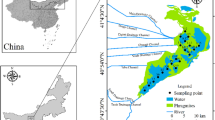Abstract
Analysis of Zn, Cu, Pb, Co, Cr, Li, Ni, K, Al, Fe extracted by 1 mol/L HCl or 0.5 mol/L HCl/H2O2 showed concentrations of Zn, Cu, Pb, Co, Cr, Fe, N: were significantly correlated with Li, Al, K, and day. Two methods are used to indicate the background value of the non-residual phase of elements in sediments, and are the same as the methods used to indicate the background value of total concentrations in sediments. The first method uses correlograms and regression equations, the second uses the mean element concentrations normalized with grain size.
Li, Al, K can be used as reference elements to determine the background value of Zn, Cu, Pb, Co, Cr, Ni, Fe, while the clay concentration's correlation with some extractable concentrations can be used to calculate the background value of the non-residual phase of elements as a percentage of clay concentration in the sediments. Based on this study, the concept of using the background value of the non-residual phase of elements to compare the pollution level in different areas is advanced as a very important method for further research.
Similar content being viewed by others
References
Li Fengye, 1985. Continuous determination of K, Na, K, Mg in marine sediment (AAS).Mar. Science 9(1): 21–23. (in Chinese with English abstract)
Loring, D. H., 1990. Lithium—a new approach for the granulometric normalization of trace metal data.Mar. Chem. 29: 155–168.
Peter, J. Hanson, David, W. Evans, David R. Colby, 1993. Assessment of elemental contamination in estuarine and coastal environments based on geochemical and statistical modeling of sediments.Mar. Enviro. R. 36: 237–266.
Interpretation of metal concentrations in estuarine sediments of Florida using aluminum as a reference element.Estuaries, 13: 227–235.
Wei Fusheng, Qi Wenqi, 1988. AAS and Its Application in Environment Analysis. Chinese Environmental Science Press, Beijing, pp. 212–215.
Wu Jingyang, 1984. Detection of background values of some heavy metals in marine sediments on basis of Nickel content.KEXU TONGBAO (Science Bulletin)29(9): 1223–1226.
Zeng Xiangjing, Miu Xinzhen, Huang Benli, 1986. The determination of Cr and Mn by AAS. Preparation, analysis and determination of environmental standard reference materials. Science Press, Beijing, pp. 17–21.
Author information
Authors and Affiliations
Additional information
Contribution No. 2379 from the Institute of Oceanology, Chinese Academy of Sciences.
Rights and permissions
About this article
Cite this article
Xin-wei, L., Jing-yang, W., Yue-qin, C. et al. Background study on non-residual phase of elements in Changjiang and Huanghe Estuarine sediments. Chin. J. Ocean. Limnol. 14, 282–290 (1996). https://doi.org/10.1007/BF02850392
Received:
Accepted:
Published:
Issue Date:
DOI: https://doi.org/10.1007/BF02850392




